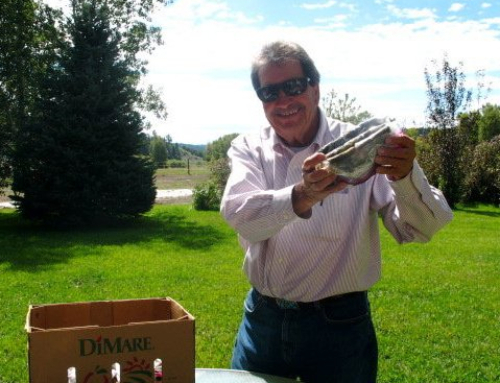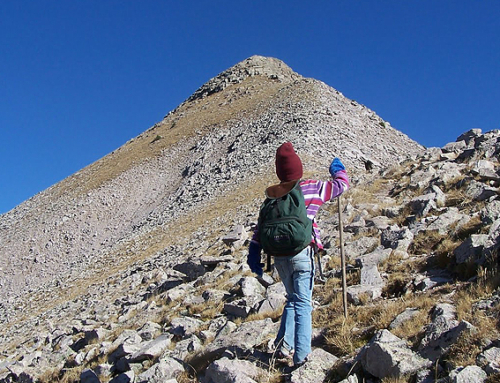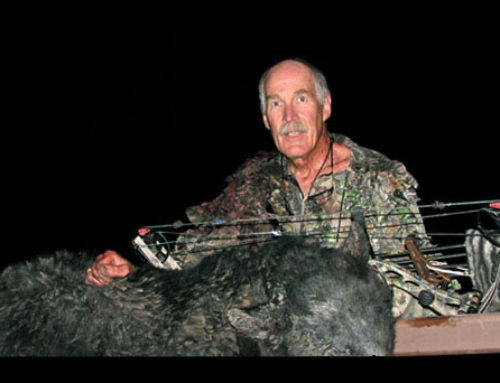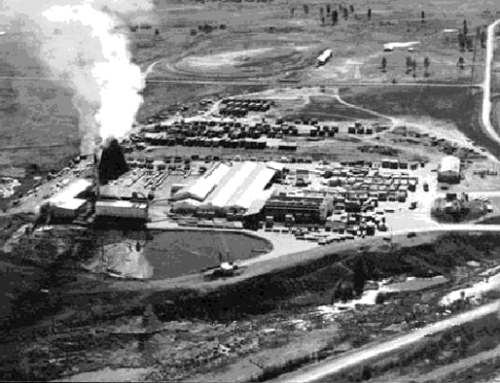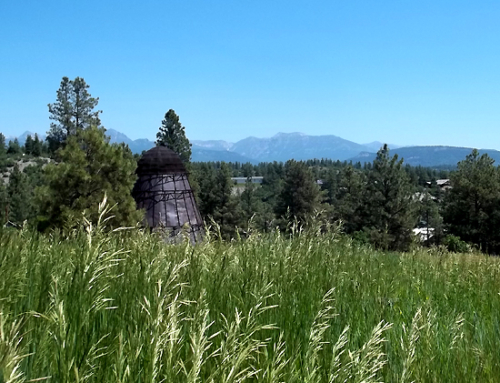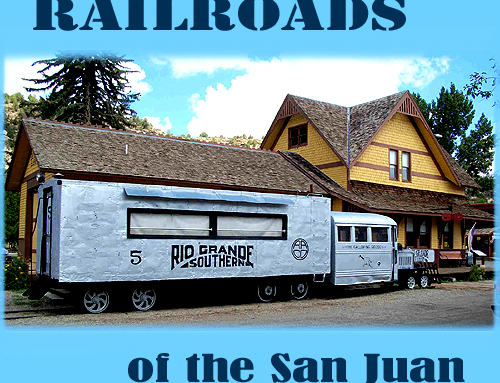Nina Archuleta-Stotlar, great-granddaughter of the late Margaret Archuleta-Daugaard, models the Gomez-Garcia-Archuleta family heirlooms, a hand woven silk shawl and an emerald and gold necklace. These objects were brought from Spain on the Juan de Onate expedition in 1626. A few years ago the necklace was requested and put on display at the Smithsonian Institute in Washington D.C. These items are kept in a bank vault and are the most valuable objects in Pagosa Country.
.
 This article is based on the book To The Inland Empire by Stewart Udall, on file at the Sisson Library. It is about the first Spanish pioneers, and how their history enters into Pagosa Country.
This article is based on the book To The Inland Empire by Stewart Udall, on file at the Sisson Library. It is about the first Spanish pioneers, and how their history enters into Pagosa Country.
The book provides a different view of western hemisphere and United States history, specifically that the Spanish were the original discoverers and settlers, and that this history has been, and still is, diminished and altered by Anglo Saxon historians. Indeed, ask most U.S. citizens, from seniors to our current crop of middle-schoolers, who the United States’ pioneers and settlers were, and you are likely to hear about Captain John Smith and Jamestown, Virginia, about the Mayflower and the Pilgrims and others related to the colonization of the east coast. Few will know of Cabeza de Vaca, Esteban the Moor, or Juan de Onate who were some of the first true United States pioneers and settlers.
In April 1605, Juan de Onate stood before a stone wall in the area that would become New Mexico. He saw, etched into the sandstone, petroglyphs pecked by ancient people who once lived there. Juan withdrew his dagger and carved his name in the stone. It must have been a proud moment. He put his mark with the others to say, “I live here now!” Onate’s mark is now in Elmoro National Monument, New Mexico, and is the oldest known European signature on our continent.
Juan de Onate was the first person to envision, and then carry out, a permanent settlement in what is now the United States. Spanish explorers reported back to Spain on the vast new continent discovered a half-century before. Most of the people who joined Onate grew up hearing reports of Spain’s heroes – Columbus, Cortez, Coronado, and others. Their discovery and conquest of a new world startled and excited the population in Spain. Onate knew that the rush to gain riches had been fruitful, but was over. He saw the riches in the land itself, that if a number of families could be found that were brave and strong and willing, a settlement could be set up in this distant land.
The word “brave” was a key word for this venture, as significant settlement had been tried before and failed. Settlers from other European countries tried, gave up and returned to Europe. Some were killed by mishap or war with Indians, or in the case of settlers in Virginia, mysteriously vanished. “Strong” is another key word for Onate’s settlers. Ocean voyages had been accomplished by professional explorers and sailors for a relative brief half a century, but families were still a rarity on the open sea.
The ocean voyage was only the beginning. The plan for these colonists was to land in Mexico and travel overland for hundreds of miles following the Rio Grande River north. They carried with them everything to start their new lives, from personal items to seeds and farm animals. This was one of the most daring colonizing expeditions in all of human history, a testament to their courage and tenacity that they made the voyage and survived.
Fifty-three families came, followed the river and settled in the Chama River Valley a short distance south of Pagosa Country. At first the men came and later the women and children. Life was hard for the first pioneers and harder for their children and grandchildren. In 1680, several Pueblo Indian tribes in the area drove the colonists south into Mexico. In 1695 Spanish dominion was restored by soldiers, and the families returned to settle the land again.
The pioneer families were joined by more colonists, and the settlement expanded. Life got better when in 1821 the Santa Fe Trail opened, allowing easier travel and communication with the rest of the country. The United States was formed as a country on the east coast, and its military power was rapidly expanding west into the area of Spanish settlement.
As time passed, the Spanish moved north into the foothills of the San Juan Mountains and into Pagosa Country in the 1870s. At the same time people from the east were also moving into Pagosa Country. Today it is remarkable that half of the surnames listed on Onate’s original manifest are prominent in Pagosa Country. Look around at the proud Hispanic faces in Pagosa Springs. Some of them are direct ancestors of the “first families” of the United States.
The main theme of Inland Empire, by Stewart Udall, tells the history of Spanish exploration in the sixteenth century, and how this history has been unfairly altered and ignored. Many of Pagosa Springs’ Hispanic families are direct descendents of the Spanish explorers and settlers described here.
In the sixteenth century, Spain was the “super power” of the world. Spanish leaders sent exploration expeditions across half of the earth, previously unknown to the population of the eastern hemisphere. This was the “Great Age of Discovery.” Spain not only discovered the Americas, but made overland expeditions deep into new continents and set up permanent settlements. No other country sent forth such an armada of explorers. This was half a century before the English and French set up small permanent settlements on America’s east coast. Udall asks why it is that when the average American is asked about early American history, he or she usually describes English adventures on the east coast of the U.S.A.
Udall states, “It is puzzling that we Americans have ignored or disavowed a century we should view with fascination and pride. Events that changed the world occurred on our continent and some who participated in those developments were the first Europeans to see our shores and walk on our lands.”
“What explains this lapse? How did we lose an invigorating chapter of our national story? How can a nation that celebrated John Smith and William Bradford slight founders who preceded them in other parts of the United States? And why have we been so grudging in contributions made in the dawn years of our history by people with Spanish surnames?”
“To find answers to those questions, one must hark back to the final decades of the sixteenth century, when Spain bestrode Europe and Englishmen began to nurture the ambition that they, too, might build an overseas empire. It was the hatreds evoked by the Protestant Revolution and the desire of the English and Dutch to undermine the Spanish colossus that the first dark shadows on Spanish character began and gave birth to a ‘Black Legend’ that Spaniards are innately cruel and depraved.”
“For readers of English, it was a single remarkable man, the Reverend Richard Hakluyt, who launched a propaganda campaign that distorted Spain’s great age of discovery and denigrated the character of her people.”
Udall tells about Richard Hakluyt, an Englishman, who began an anti-Spanish propaganda campaign using the Royal Printing Press. Udall continues, “Hakluyt’s articles convey the false impression that English exploration ran on a track parallel to that followed by Spain’s great discoverers. Hakluyt galvanized his country. However what concerns us here is how he and his successors distorted sixteenth-century history and robbed us of the Spanish part of our national story.”
“As a self-appointed publicist for a greater England, Hakluyt faced two troublesome problems as he surveyed the events that brought the dynamics of the New World expansion into the very center of European life. It was undeniable, for example, that by 1580 Spain and Portugal had already completed great epochs of exploration and dominated the world’s seas. And it was equally undeniable that England had been inactive during the glory days of the first half of the sixteenth century.”
“But a resourceful propagandist is not deterred by disagreeable facts. With anti-Spanish sentiment at a fever pitch in Queen Elizabeth’s court, Hakluyt realized he was free to manipulate facts and tilt history as he pleased. This resulted in ‘histories’ that glorified English accomplishments, ignored Spain’s ‘climatic epoch’ and ‘spawned English fables that obliterated historic facts’. Hakluyt had a deft touch. He outlines sixteenth century history by muddling events, dates, and the deeds of individual nations. The technique so jumbled the two halves of the sixteenth century that it only dimly resembled the facts. Instead, there emerged the convenient concept of an ongoing age of discovery by English and other non Spanish historians began describing it as an ‘European experience’ that was an outgrowth of ‘European initiatives’.”
Hakluyt set a trend, tilting history away from Spanish success and toward English-European success that was later repeated by most Anglo-Saxon historians. For example, a five volume History of the American People, by Woodrow Wilson, had not a word about Spanish pioneering in this country.
A great deal of history has gone untold. The adventures and exploration of Cabeza de Vaca, Esteban the Moor, Alfonso de Castillo and Andres Dorantes is an epic in its own right. De Vaca and his comrades were the only survivors of a 400-man expedition that vanished in the swamplands of Florida in 1528. They paddled across the Gulf of Mexico and began living as “white Indians” with the natives in the area of Galveston, Texas. They began a trek across the country, with each step a stride off the edge of the known world. They lived with many tribes of Indians, none of whom had previous knowledge of white men. They began using their skills to heal sick Indians and became famous in the area as white “medicine men.” At times there were thousands of Indians following them on the journey west. Their wanderings went across what is now Texas, New Mexico, and Arizona, to the west coast of Mexico. In 1536, after eight years of walking, they were approached by a native wearing a Spanish horseshoe nail around his neck as an amulet. All they knew was that at the time of their wreck other Spanish explorers were planning to go to Mexico and then explore northward. De Vaca and his party had found them!
The members of the De Vaca party were the first Europeans to cross North America from sea to sea. They were the first to provide information about the land mass of America. They were the first to enter into good relationships with Indians. Udall’s book continues on to explain that the expedition of Francisco Vazquez de Coronado began the conquest and settlement of most of the Western United States. Coronado’s journey is better known and covered in most history books.
Udall concludes, “With the Hispanic segment of our population increasing each year, the gains would be substantial if we had the wit to widen our horizons and pluck our Spanish century from the waste basket of history.”
“The deeds of these American pioneers resonate through the annals of our history, and the imprint they and their ancestors left on our culture is both permanent and profound. It is time to bring them out of the shadows and into the sunlight. They will add a special luster to our national story.” by Stewart Udall, is available from the Sisson Library. Udall, a well-known and respected scholar, is a U.S. Senator from Arizona and has been a statesman for several presidents.
Inland Empire


